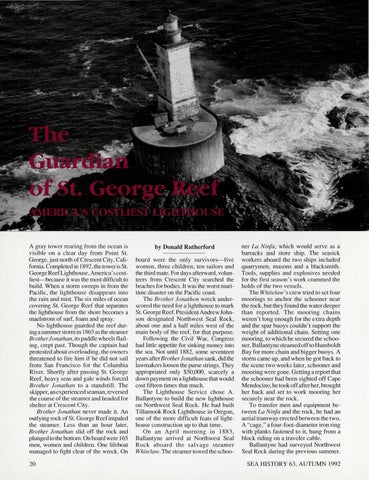A gray tower rearing from the ocean is visible on a clear day from Point St. George, just north of Crescent City, Califomia. Completed in 1892, the tower is St. George Reef Lighthouse, America's costliest-because it was the most difficult to bui ld. When a storm sweeps in from the Pacific, the lighthouse disappears into the rain and mist. The six miles of ocean covering St. George Reef that separates the lighthouse from the shore becomes a maelstrom of surf, foam and spray. No lighthouse guarded the reef during a summer storm in 1865 as the steamer Brother Jonathan, its paddle wheels flailing, crept past. Though the captain had protested about overloading, the owners threatened to fire him if he did not sail from San Francisco for the Columbia River. Shortly after passing St. George Reef, heavy seas and gale winds forced Brother Jonathan to a standstill. The skipper, an experienced seaman, reversed the course of the steamer and headed for shelter at Crescent City. Brother Jonathan never made it. An outlying rock of St. George Reef impaled the steamer. Less than an hour later, Brother Jonathan slid off the rock and plunged to the bottom. On board were 165 men, women and children. One lifeboat managed to fight clear of the wreck. On 20
by Donald Rutherford board were the only survivors-five women, three children , ten sailors and the third mate. For days afterward, volunteers from Crescent City searched the beaches for bodies. It was the worst maritime disaster on the Pacific coast. The Brother Jonathon wreck underscored the need for a lighthouse to mark St. George Reef. President Andrew Johnson designated Northwest Seal Rock, about one and a half miles west of the main body of the reef, for that purpose. Following the Civil War, Congress had little appetite for sinking money into the sea. Not until 1882, some seventeen years after Brother Jonathan sank, did the lawmakers loosen the purse strings. They appropriated only $50,000, scarcely a down payment on a lighthouse that would cost fifteen times that much. The Lighthouse Service chose A. Ballantyne to build the new lighthouse on Northwest Seal Rock. He had built Tillamook Rock Lighthouse in Oregon, one of the more difficult feats of lighthouse construction up to that time. On an April morning in 1883, Ballantyne arrived at Northwest Seal Rock aboard the salvage steamer Whitelaw. The steamer towed the schoo-
ner La Ninfa , which would serve as a barracks and store ship. The seasick workers aboard the two ships included quarrymen, masons and a blacksmith. Tools, supplies and explosives needed for the first season ' s work crammed the holds of the two vessels. The Whitelaw' s crew tried to set four moorings to anchor the schooner near the rock, but they found the water deeper than reported. The mooring chains weren't long enough for the extra depth and the spar buoys couldn't support the weight of additional chain. Setting one mooring, to which he secured the schooner, Ballantyne steamed off to Humboldt Bay for more chain and bigger buoys. A storm came up, and when he got back to the scene two weeks later, schooner and mooring were gone. Getting a report that the schooner had been sighted off Cape Mendocino, he took off after her, brought her back and set to work mooring her securely near the rock. To transfer men and equipment between La Ninfa and the rock, he had an aerial tramway erected between the two. A "cage," a four-foot-diameter iron ring with planks fastened to it, hung from a block riding on a traveler cable. Ballantyne had surveyed Northwest Seal Rock during the previous summer. SEA HISTORY 63, AUTUMN 1992
